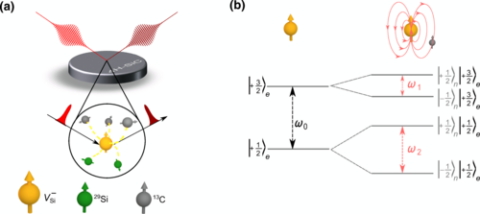The first publication of our group was published in Physical Review Applied
Scalable Quantum Memory Nodes Using Nuclear Spins in Silicon Carbide
A distributed quantum network would require quantum nodes capable of performing arbitrary quantum information protocols with high fidelity. So far the challenge has been in realizing such quantum nodes with features for scalable quantum computing. We show here that using the solid-state spins in 4H silicon carbide (4H SiC) such a goal could be realized, wherein a controlled generation of highly coherent qubit registers using nuclear spins is possible. Using a controlled isotope concentration and coherent control we perform here atomistic modeling of the central spin system formed by the electron spin of a silicon-vacancy color center (V–Si center) and the noninteracting nuclear spins. From this we lay out conditions for realizing a scalable nuclear-spin (13C or 29Si) register, wherein independent control of the qubits alongside their mutual controlled operations using the central electron spin associated to the V–Si center in 4H SiC are achieved. Further, the decoherence and entanglement analysis provided here could be used to evaluate the quantum volume of these nodes. Our results mark a clear route towards realizing scalable quantum memory nodes for applications in distributed quantum computing networks and further for quantum information protocols.
This is the first publication which we published as an independent research group. Congratulations for these great results, Shravan!
The paper can be found here.
